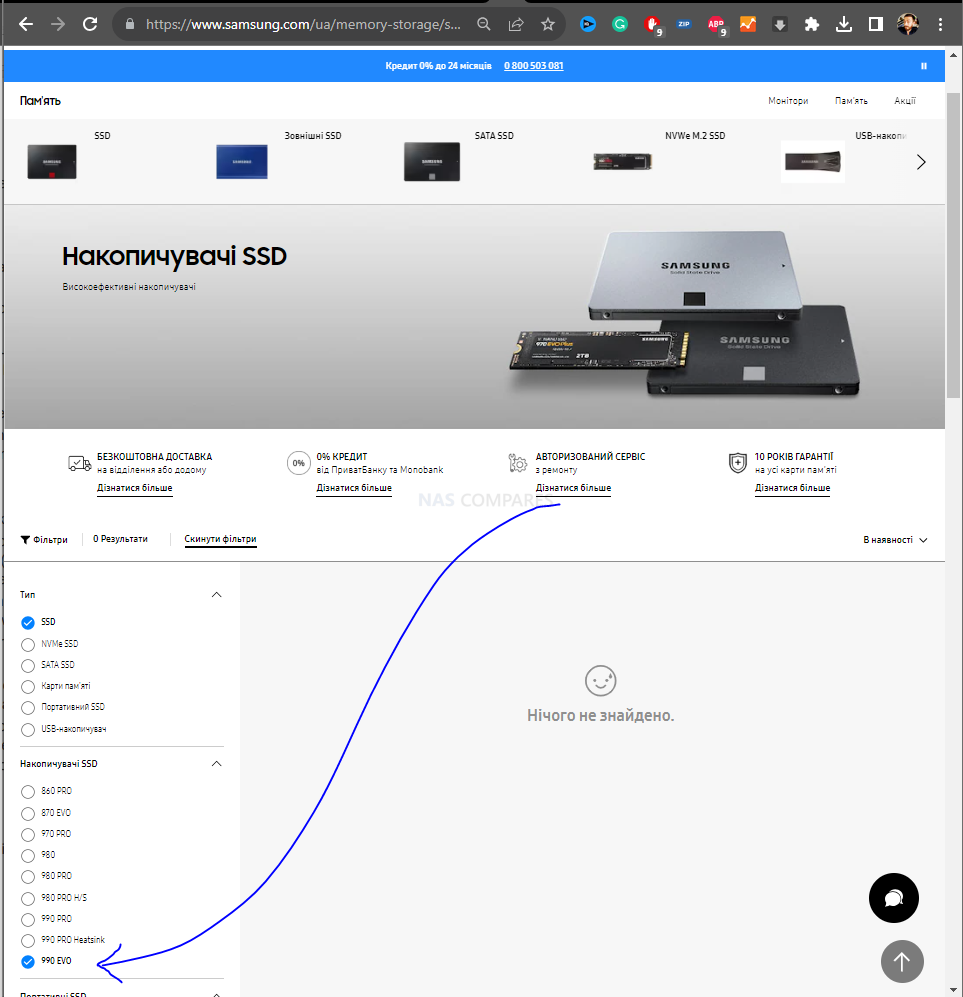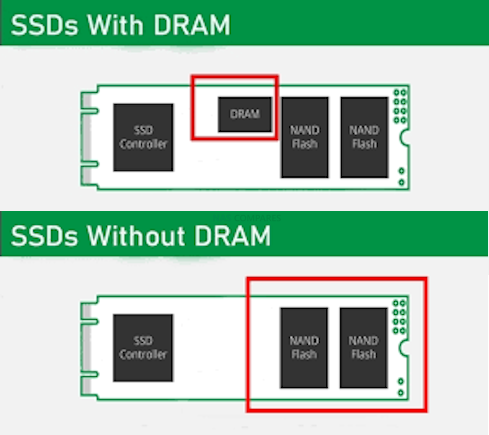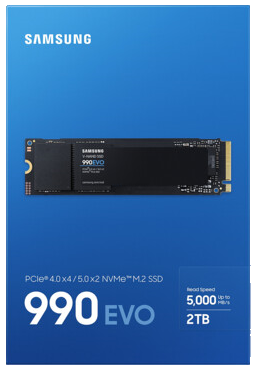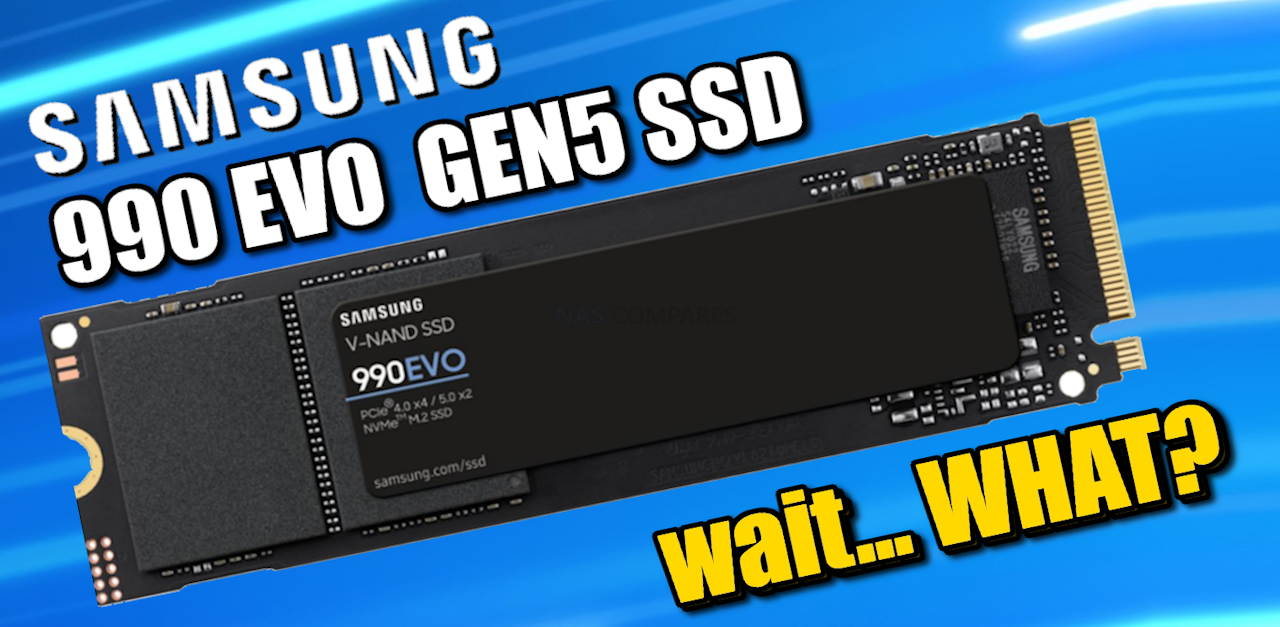Samsung Finally Releasing a Consumer Gen5 SSD – The 990 EVO M.2 NVMe SSD
With so many Gen 5 SSDs being revealed during CES 2024, it probably won’t come as a tremendous surprise that Samsung (a big [player in both the consumer and business SSD market) is on the verge of rolling out its very first consumer-focused PCIe Gen 5M.2 NVMe SSD – The Samsung 990 EVO.

As surprising as it might sound, although home/consumer Gen 5 SSDs have been rolling out for the better part of 2 years, Samsung held off rolling out their own till now. That isn’t to say that they have ignored this area of the market, though all attention from them towards Gen5 storage has been exclusively enterprise-focused (eg the PM1743 Flash), but many were surprised how long it was taking them to enter the growing Gen5 SSD marketplace. Rewind back to the Samsung 980 Pro Gen 4 launch in Nov 2020, wiping practically every other Gen4 drive off the map at that time in terms of performance, and you can see why users have been rather perplexed on Samsung’s reluctance this time around. However, better late than never, right? Thank you numerous leaks online spotted by ComputerBase.de, which ranged from the Samsung Magician tool leaking the 990 EVO product name, and to references on the PCISiG here.

Source – ComputerBase

Then there was an appearance (albeit briefly) of the official product being listed on official UA Samsung pages, although now largely just resulting in a blank search result (see below). Finally, it appeared on Amazon Germany, at €115 and €190 for the 1TB and 2TB models respectively (both now taken offline) which listed delivery as the 25th of Jan and 24th of February – so clearly we are looking at drives that are pretty much imminent for official launch!
So, now we know the Samsung 990 EVO exists – should you care? With so, so many Gen5 SSDs being released or revealed in Q1 2024, have Samsung left this a little too late? Let’s discuss the specifications we know about.
The Samsung 990 EVO SSD Hardware Specifications
I think it would be an understatement to say that Samsung have “gone their own way” when it comes to the Samsung 990 EVO SSD. As mentioned earlier, they have certainly approached it differently to the Gen4 generation of SSDs where they took a early massive lead across the whole market with the (still popular) Samsung 980 PRO.The hardware specifications of the Samsung 990 EVO are…unusual, in a conventional sense. Samsung has clearly decided that the Samsung 990 EVO is a drive targeting the bridging between Gen4 and Gen5 users, as well as low power use and economical SSD buyers. In short, this drive is not designed with performance in mind – which is going to sound rather unusual, given that is the focus of 99% of the rest of Gen5 SSDs launched in the last 18 months. The Samsung 990 EVO is a Dramless (i.e no onboard memory/DRAM) that can be used on a Gen 4 connection to 4×4 bandwidth or a Gen5 connection at 5×2. The result is that this more economical and efficiency-focused drive peaks at 5,200MB/s (5.2GB/s) Sequential Read and 4,200MB/s (4.2GB/s) Sequential Write. This rather pales in comparison to the Gen 4×4 Samsung 990 PRO at 7,450MB/s and 6,900MB/s Seq Read/Write respectively. This lower peak performance also extends to the 4K Random IOPS at 700K/800K Read//Write respectively on the 990 EVO vs the 1.5Million and 1.6Million 4K R/W IOPS of the 990 PRO. Alot of these shortfalls can be attributed to the lack of onboard memory (with the drive relying on using a portion of host client memory, aka HMB) and the PCIe Gen 5×2 architecture – but the drive hitting these numbers in a 4×4 environment is a little disappointing (even when you consider the efficiency focus that this drive has been built under). Here are the specs:
The following specifications are based on the above-leaked information from ComputerBase, cached pages that are now offline and using specifications of similar OEM PM9C1a SSD that shares many similarities with the Samsung 990 EVO SSD:
 |
|
|---|---|
| Model | Samsung SSD 990 EVO |
| Interface | PCIe 4.0 x4 / 5.0 x2 NVMe 2.0 |
| Capacity | 1TB, 2TB (Possible 4TB) |
| Controller | Samsung in-house Controller |
| NAND Flash Memory | Samsung V-NAND TLC (176-layer TLC V-NAND V7 ? TBC |
| Memory | HMB (Host Memory Buffer) |
| Form Factor | M.2 (2280) |
| Sequential Read | Up to 5,000MB/s |
| Sequential Write | Up to 4,200MB/s |
| 4K IOPS Random Read | 680KIOPS (1TB), 700KIOPS (2TB) (TBC) |
| 4K IOPS Random Write | 800KIOPS (TBC) |
| MTBF | 1.5 million hours |
| Warranty | 5 years limited, TBW: 600TB (1TB), 1,200TB (2TB) (TBC) |
| Supporting Features | TRIM, Garbage Collection, S.M.A.R.T |
| Data Security | AES 256-bit Full Disk Encryption, TCG/Opal V2.0, Encrypted Drive (IEEE1667) |
The Samsung 990 EVO is PCIe Gen 5×2 – Wait, What?
So, let’s drill into that 5×2 / 4×4 architecture a little and look at the positives. On the face of it, technically ALL Gen5 SSDs can work at 4×4 if placed in a 4×4 M.2 slot – that is the nature of PCIe backwards compatibility. However, if you place a Gen4 drive in a Gen5 m.2 slot, you will be downgraded to Gen4 speeds (no different than a USB 2.0 device in a USB 3.2 connector). The Samsung 990 EVO allows this 4×4 drive to enjoy 5×2 speeds in devices with carefully curated PCIe lane layouts or PCIe cards that have to be very selective about the allocation (i.e RAID cards of combo storage/network cards). Additionally, in devices such as ultra-thin laptops and compact mini PCs, heat is a real concern and 5×4 architecture will noticeably reduce power consumption and lessen the need for comprehensive heat dissipation.

However, we also have to look at this objectively and as a new buyer considering a Gen 5 SSD in 2024, and in that context the Samsugn 990 EVO is a rather odd proposition. First, there is the fact that this drive seemingly under performs compared with the majority of Gen 4 SSDs released in the last 4 years (many of which carry at minimum 5,500MB/s Seq Read performance and most now surpassing 7,000MB/s). Even if you make a direct comparison with a DRAMless Gen4 SSD that relies on Host Memory Buffer released back in 2022, such as the WD Black SN700 (currently at $75 for 1TB and $119 for 2TB), that drive still hits 5,150MB/s and 4,850MB/s Seq R/W and 650/800K IOPS – which is VERY close to what the 2024 releasing Samsung 990 EVO is proposing here. It’s an odd choice to make their first consumer(ish?) focused M.2 SSD for the Gen5 tier a Gen 5×2 drive and DRAMless, as these are the sort of specifications I expect in a more specialized/OEM drive that likely goes directly in a laptop at production or in bulk in a more PCI curated RAID card. Gen 5×2 is by no means a common m.2 bandwidth allocation and although many system allow customization at BIOS/Chipset for efficiency, most Gen5 buyers are looking at this generation with performance as the driving motivator. We are still awaiting confirmation on details such as durability (DWPD/TBW), but one imagines that with such a focus on efficiency and power consumption savings, that durability on this drive will be welcomingly high! Lets drill down a little into the choice to go ‘RAM free’ on the Samsung 990 EVO Gen5 SSD.
The Samsung 990 EVO is DRAMless – Why?
Much like the choice by Samsung to opt for the Gen 5×2 architecture, there are pros and cons to this kind fo drive that are going to result in it being a much more specialized drive than many would like. DRAMless SSDs, like the Samsung 990 EVO, represent a significant evolution in solid-state drive technology. The primary advantage of DRAMless SSDs is their cost-effectiveness. By eliminating the DRAM cache, these SSDs reduce manufacturing costs, making them more affordable for consumers. This is particularly beneficial for those who require high-capacity storage but are constrained by budget. Additionally, DRAMless SSDs tend to consume less power, as they don’t have to power a separate DRAM module. This lower power consumption makes them an ideal choice for use in laptops and mobile devices, where battery life is a crucial factor. The Samsung 990 EVO leverages Host Memory Buffer (HMB) technology, which uses a portion of the system’s RAM instead of having its own dedicated DRAM. This approach can maintain a balance between performance and cost, offering decent speeds that are suitable for everyday use and mainstream applications.

However, the absence of a dedicated DRAM cache in DRAMless SSDs can also lead to certain drawbacks. The most significant of these is the potential reduction in performance, especially in write-intensive scenarios or when handling large files. DRAM in traditional SSDs acts as a high-speed buffer for the mapping table, which keeps track of where data is stored on the drive. Without this, the SSD has to rely on slower NAND or the system’s RAM (as in HMB technology) for these operations, which can result in slower write speeds and increased latency. For the Samsung 990 EVO, this might not be a significant issue for average users, but for professionals and enthusiasts who require high-performance storage for tasks like video editing, gaming, or heavy data processing, the difference could be noticeable. Additionally, depending on the implementation, relying on the system’s RAM (as in HMB) can affect the overall system performance, especially in RAM-constrained systems.
Samsung 990 EVO Release Date and Price

There is no avoiding that the Samsung 990 EVO SDD is not a drive that is going to please everyone. There is an ongoing discussion right now on whether client hardware (laptops, servers, PCs, etc) can actually fully take advantage of the performance of Gen 5 SSDs in a sustained fashion. Affording PCIe Gen5 lanes to the SSDs is only half the battle, as the drive still needs to be able to provide the throughput and response times from the onboard NAND flash to the host system. Gen5 SSDs have been promising 12-14GB/s speeds now for around 6-8 months, but how long they can sustain that speed before oversaturation and/or heat-related throttling is up for debate. The Samsung 990 EVO is clearly a drive with a different focus and one that, in the right circumstances, makes a lot of sense. However, as a first-release by the brand in the commercial sector for Gen5, it’s an odd choice and I sincerely hope it is one that is speedily followed up (and/or dual-released alongside) a more confident Prosumer version (Samsung 1000 PRO? Samsung 990 Pro Plus?), as this si quite a niche sounding drive. Expect it to formally launch later in Jan 2024 and pricing at $119 and $199 for the 1TB and 2TB models respectively.
📧 SUBSCRIBE TO OUR NEWSLETTER 🔔 This description contains links to Amazon. These links will take you to some of the products mentioned in today's content. As an Amazon Associate, I earn from qualifying purchases. Visit the NASCompares Deal Finder to find the best place to buy this device in your region, based on Service, Support and Reputation - Just Search for your NAS Drive in the Box Below
🔒 Join Inner Circle
Get an alert every time something gets added to this specific article!
Need Advice on Data Storage from an Expert?
Finally, for free advice about your setup, just leave a message in the comments below here at NASCompares.com and we will get back to you.
 Need Help?
Where possible (and where appropriate) please provide as much information about your requirements, as then I can arrange the best answer and solution to your needs. Do not worry about your e-mail address being required, it will NOT be used in a mailing list and will NOT be used in any way other than to respond to your enquiry.
Need Help?
Where possible (and where appropriate) please provide as much information about your requirements, as then I can arrange the best answer and solution to your needs. Do not worry about your e-mail address being required, it will NOT be used in a mailing list and will NOT be used in any way other than to respond to your enquiry.
TRY CHAT
Terms and Conditions


UGREEN DH2300 vs UniFi UNAS 2 - Value 2 Bay Face Off
NAS Will Never Die. And HERE is why
Minisforum N5 vs UGREEN DXP4800 PLUS - Which $599 NAS is Better?
When is HexOS Going to be worth $299?
Is it OK to Buy Synology Again?
UniFi UNAS - 1 Year Later - Should Synology and QNAP Be Worried?
Access content via Patreon or KO-FI
Discover more from NAS Compares
Subscribe to get the latest posts sent to your email.









Whats the benefit of pcie 5.0 on the 990 EVO if the Pcie 4.0 990 pro reaches higher speeds?
REPLY ON YOUTUBE
M80 will not fit to hold down T700 Crucial M.2 5.0 in the first slot? What size is the screw that holds it down?
REPLY ON YOUTUBE
I would love if modern motherboards offered the slots the ability to drop down to x2 for the m.2 slow so you can assign the limited lanes to other components. If could get performance equivalent to say a Seagate 530 at x2 I’d buy these all day long over the full speed drives.
REPLY ON YOUTUBE
Dram matters more than that for when you eventually turf it out to an USB enclosure where there is no HMB, also HMB can’t compare with gigs of dram, windows only allocates like 64MB~
REPLY ON YOUTUBE
I’ve been waiting for Samsung to make a Gen 5 move… but this aint’ it.
REPLY ON YOUTUBE
this is supposed to be the entry level successor to the standard samsung 980 (pcie gen 3 DRAMless)
REPLY ON YOUTUBE
Something is wrong with screen recording. Even with 1080p it very pixelated when you’re showing specs.
REPLY ON YOUTUBE
get an adblocker sheesh those websites you are showing are completely unreadable
REPLY ON YOUTUBE
Why no 4tb version come on samsung we need a 990 Evo plus 4tb
REPLY ON YOUTUBE
Always on top of your game
REPLY ON YOUTUBE
ts a Ferrari badge with a Ford underneath. Its gen 4.5 at best more likely 4.05. Even the cat wasn’t impressed.
REPLY ON YOUTUBE
Most people won’t notice the difference between gen 3×4 and gen 4×4, much less 5.
REPLY ON YOUTUBE
When you say the first 7000 Megs drive it gets me confused. It’s not the first 7 TB capacity drive on the market is it? Did you mean 7 TB/s or 7000 MB/s throughput instead?
REPLY ON YOUTUBE
NVMe SSDs do provide amazing performance BUT Gen3 and Gen4 generate MASSIVE amounts of heat if you need to perform sustained writes to the devices. It’s very easy to end up in the situation where NVMe drive throughput is throttled due to “overheating” even when using solid aluminium external enclosures with heat transfer pads. I suspect NVMe Gen5 will make this issue even worse and some already appear to have silly sized/heat-pipe heatsinks stuck on top of them to try to address this issue.
REPLY ON YOUTUBE
No DRAM is actually good for servers if you don’t have Power Loss Protection on the drive as the reason for PLP is so that any data in cache needs power to write to NAND if there is a power failure or other interrupt.
REPLY ON YOUTUBE
FikWot???
YouTuber Professor Simon Holland just released a video promoting FikWot SSDs! (I have never heard of them).
He subjectively compares them to Samsung.
https://youtu.be/a_PJlLwXwA8?si=bPsMtQSkj-CVRNcS
REPLY ON YOUTUBE
I bet you have NAS units hidden in your bed also! They’re EVERYWHERE! 😀
REPLY ON YOUTUBE
This drive makes no sense whatsoever.
REPLY ON YOUTUBE
An excellent review in a space of great interest to me. Well done. Regards mark
REPLY ON YOUTUBE
Thanks
REPLY ON YOUTUBE
Thank you VERY much for delivering all those information!
REPLY ON YOUTUBE
So when will I be able to upgrade from my 2TB samsung 990 pro and my 2TB WD SSD Black SN850? The sequential read speeds do have /some/ value for me for game loading. But I don’t game much today. And so far the only statistic I care about (random read/write) is slower on all Gen5 SSDs than on my Gen4 SSDs
REPLY ON YOUTUBE
Are there any computers currently available that can support gen 5 SSDs?
REPLY ON YOUTUBE
Ideal and most comprehensive review i’ve ever seen. An example how all reviews have to be done
REPLY ON YOUTUBE
Lmao imagine adata follows the gen 5 trend of 2gb per tb. That would mean 16gb of ram on their 8tb ssd lmao. Hell honestly id take 8gb seeing theres no consumer 8tb nvme ssd with even more than 2gb as far as im aware.
REPLY ON YOUTUBE
Must have rocks such in mouth. Keeps saying coaxia not kioxia (key-oxe-see-ah) ????️????????️????️
REPLY ON YOUTUBE
I’d be interested in a video that goes though the pros and cons of these three NAS operating systems head to head for converting an old computer to a NAS – XPEnology / Truenas / Unraid
REPLY ON YOUTUBE
Safe trip home.
REPLY ON YOUTUBE
Adata’s “water cooling” is just a gimmick. There was some ram that had something similar, I don’t recall who made it but I do remember it did nothing. Having a heat pipe and fins would be way better for heat dissipation in a package that big.
REPLY ON YOUTUBE
I don’t think the consumers need a big ssd m2 package with a big heatsintk. I would prefer a slower but slim m2 ssd for my laptop, PC or home server.
REPLY ON YOUTUBE
This comes at the right moment as we are preparing to replace our older NetApp storage that I have been managing for almost 4 years now. I envision to see an enormous amount of power savings on the whole expensive fiber channel infrastructure moving into ISCSI and NFS and into less rack space. This will become a truly hybrid setup where we can switch between on premise and cloud in real time and not in some dreamed up “architect’s” mind six years ago.
REPLY ON YOUTUBE
Did you visit Solidigm and if so what do you think of there software update?
REPLY ON YOUTUBE
NICE
REPLY ON YOUTUBE
And no seagulls at least yet.???? I’m actually missing you say that…. Lmao….
REPLY ON YOUTUBE